
Electric cars are here to stay and, if you’re in the market for one, the range of options is growing by the day. Pretty much any automaker that wants to remain relevant is set to bulk out their portfolio of EV models over the next couple of years. Even though we’re halfway through 2021 there are still quite a few pencilled in to appear this year alone.
Manufacturers are also doing the decent thing and rolling out new electric cars to suit all kinds of buyers. While there are plenty of sensible models that include compacts, saloons and the ever-present SUV, there’s also a steady trickle of high-performance EVs appearing on the horizon. In fact, from battery-powered hypercars through to pick-up trucks there’s something for everyone in our collection of forthcoming models.
- These are the best electric cars you can buy right now
- How long does it take to charge an electric car? What you need to know
- Plus: Tesla Model S is becoming a PS5 on wheels — thanks to AMD
We’ve also been taking a look at what’s going to be available farther into the future and it’s good news for the most part. Sure, if you’re a petrolhead then it might be time to shed a tear as dominance of the internal combustion engine begins to fade away. Nevertheless, there’s plenty to be positive about, and the next year or two should see a flurry of great, not to mention interesting EVs arriving.
Beyond that? Expect even wilder battery-powered designs that prove electric cars can be both green and exciting too.
Aspark Owl (Expected: 2021)

First introduced at the Frankfurt Motor Show way back in 2017, the Aspark Owl is a Japanese hypercar that’s actually already on sale in North America. The mind-blowing body styling gives you an inkling of what to expect, with performance that matches the killer lines of the car.
It’ll get from zero to 60mph in 1.72 seconds, has a top speed of 249mph and calls on a 84kWh battery in order to do it. Range is said to be in the region of 280 miles, while the four electric motors, which deliver power to all the wheels have the combined might of 1,985 horsepower and 1,475lb-ft of torque. Widespread use of carbon-fiber means it’s light and at just 39-inches high it’s mighty close to the road too. You won't get change from $3.56 million to buy it though.
Audi A6 e-tron (Expected: 2022)

Although this concept is still in development the Audi A6 e-tron is based on the hugely flexible new Premium Platform Electric (PPE) design architecture that Audi has created. This will provide the perfect foundation for this sizeable sedan, which is expected to be powered by a 100kWh battery.
Sign up to get the BEST of Tom's Guide direct to your inbox.
Get instant access to breaking news, the hottest reviews, great deals and helpful tips.
That battery drives twin electric motors boasting 469 horsepower in total. This could deliver a zero to 62mph time of just under 4 seconds. On top of that, there should be plenty of range, with up to 400 miles rumoured, plus the added benefit of an 800-volt charging capability. Although Audi will also offer other less high specification single motor models to keep prices across the range more affordable.
Audi Q4 Sportback e-tron and Q4 e-tron (Expected: 2021)
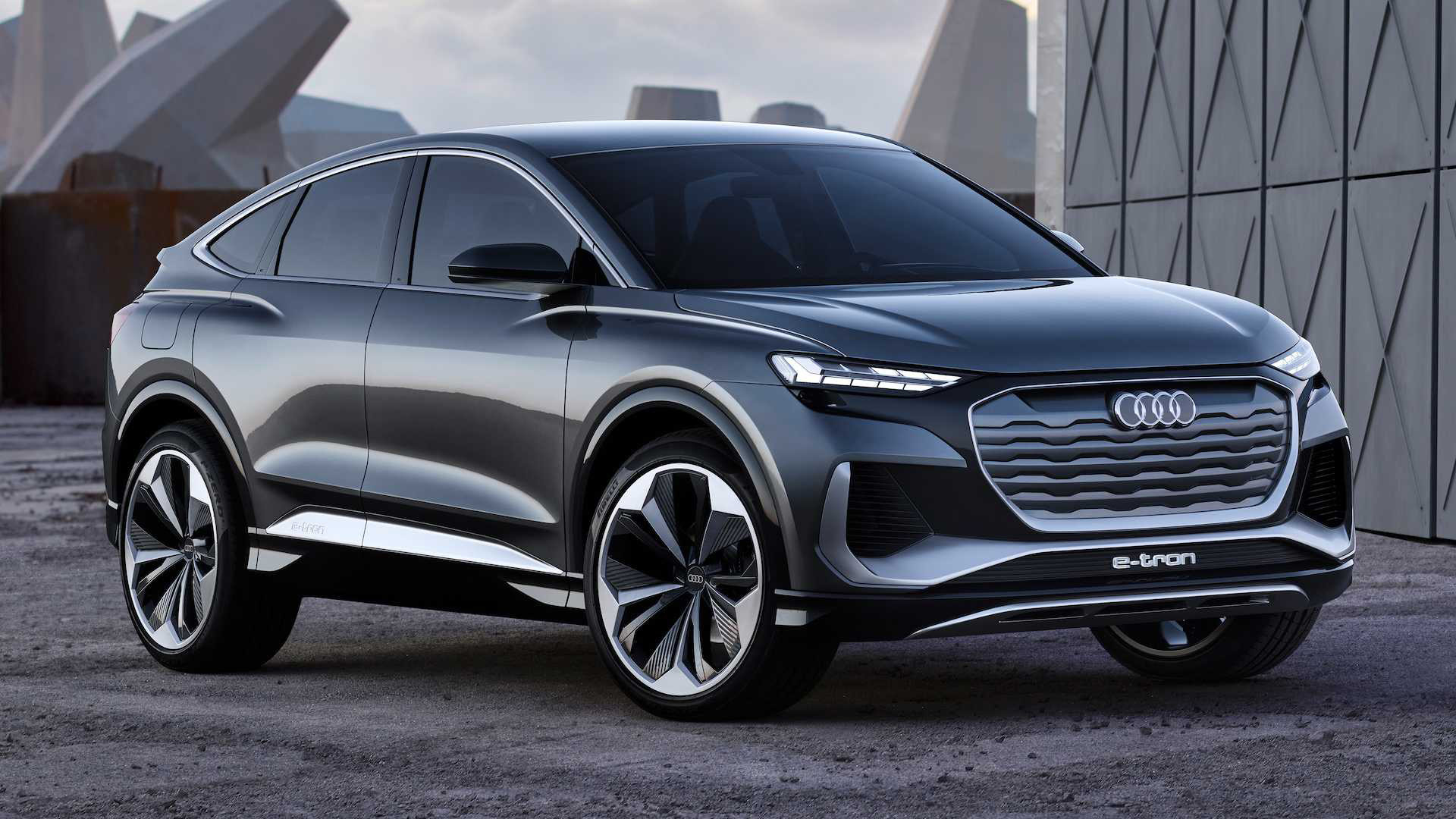
Audi’s aggressive launch plan for bringing more EVs to the U.S. has taken a tantalizing turn for the better now that it has unveiled pricing for this all-electric crossover. The Q4 e-tron, based on the German automakers MEB platform, will start at just $45,000 so it’s a few thousand cheaper than the Tesla Model Y.
Battery capacity might be just be 77kWh for the lower budget model but there’s an 82kWh all-wheel-drive variant, which Audi promises will have a range of around 250 miles. Recharging speeds of up to 125kW will be supported. Meanwhile, the interior looks set to feature recycled materials and a 10.1-inch touchscreen display up front.
BMW i4 (Expected: Late 2021)

Aside from its hard-to-miss grille, the BMW i4 is a fairly sober-looking entry that follows on from the German automaker’s 4 Series Gran Coupe. However, while there will be various models available, the highlight looks to be the model armed with 530hp thanks to an 80kWh battery pack. It looks likely to have a range of around 300 miles too.
The twin motor, all-wheel-drive model should also get the i4 from zero to 60mph in 4 seconds, aided by BMW’s eighth generation iDrive. Lookout too for an M-badged edition of the car, although pricing for any of the models has yet to be announced by BMW.
BMW iX (Expected: 2022)

Set to appear in two guises, the xDrive40 and xDrive50, the all-electric BMW iX SUV looks like being strong competition for the Tesla Model X. The cars will feature a twin-motor, four-wheel-drive arrangement that will offer 493bhp, 0 to 60mph in 5 seconds and a top speed of around 124mph. Range is expected to be in the region of 373 miles.
There’s no definite date for the arrival of the xDrive 40 in the U.S. as yet, but expect the xDrive 50 to be priced in the mid-$80,000 area. The premium SUV is likely to feature plenty of BMW luxury touches including Harman/Kardon audio along with the latest iDrive operating system.
Bollinger B1 (Expected: 2022)

If today’s packed SUV and truck marketplace doesn't deliver something to whet your appetite, then the Bollinger B1 from this Michigan start-up company with the same name might tempt you.
Things kick off with a beefy platform, which boasts a 120kWh battery pack. That pack delivers a claimed 614 horsepower, 668lb-ft of torque and provides a 0-60mph time of 4.5 seconds. With a range of up to 200 miles and the ability to carry lots of stuff, the Bollinger B1 looks more than capable. Add on a way for owners to tweak and fine-tune the SUV to their own requirements, and you’ve got a high-rise heavyweight that will certainly stand out from the crowd.
Bollinger B2 (Expected: 2022)
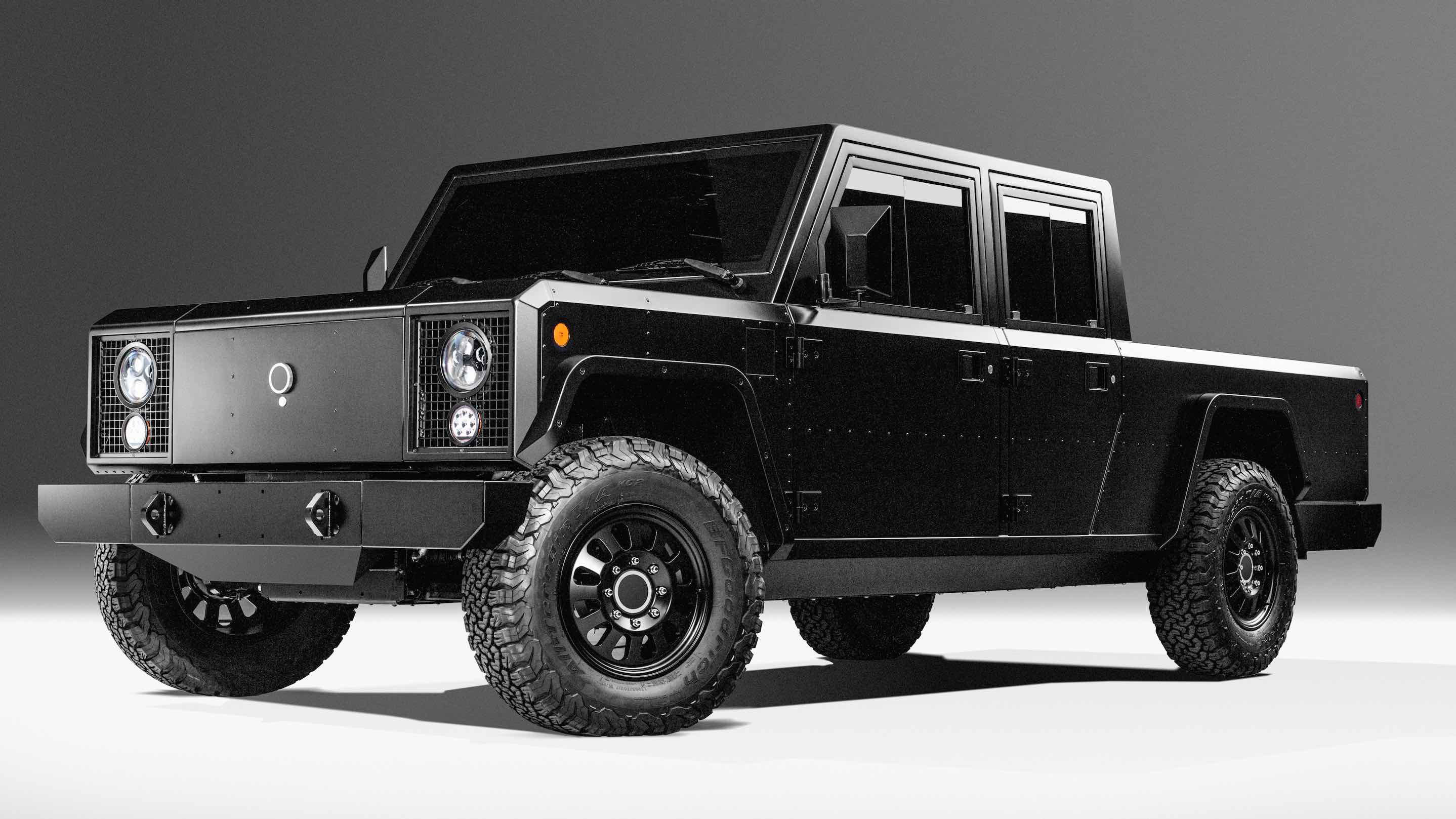
Following hot on the heels of the B1 is Bollinger’s B2, which is another gigantic offering from the Michigan-based start-up. With a price tag of $125,000 and upwards, this is a truck that’s also aimed at owners who want to customise it to meet their lifestyle needs and can afford to do so. There are foldable and removable body panels plus the convenience of a longer wheelbase than the B1.
The SUV is still built to be agile though, with dual electric motors producing 614 horsepower and 688lb-ft of torque. That also makes it a great towing option, with the ability to lug 7,500 pounds down the highway. Similarly, you can load it up with over 5,000 pounds of cargo too. It’s not cheap, but the Bollinger B2 is certainly different.
Byton M-Byte Concept (Expected: Mid-2021)

Chinese manufacturer Byton has two models pending, the M-Byte and K-Byte, both of which have been seen at auto and tech shows in concept form. The company features staff pulled in from major European automakers, and the innovation has followed suit - with the M-Byte’s dazzling dashboard proving to be a highlight for many during its appearances.
The M-Byte looks set to be keenly priced too, with a starting figure of around $45,000 in the U.S. for a 272 horsepower rear-wheel-drive edition equipped with a 72kWh battery. Byton also plans to offer a beefier 95kWh model, with two variants: a rear drive model along with a 408 horsepower, and an all-wheel-drive edition with a range of around 286 miles.
Cadillac Lyriq (Expected: 2022)
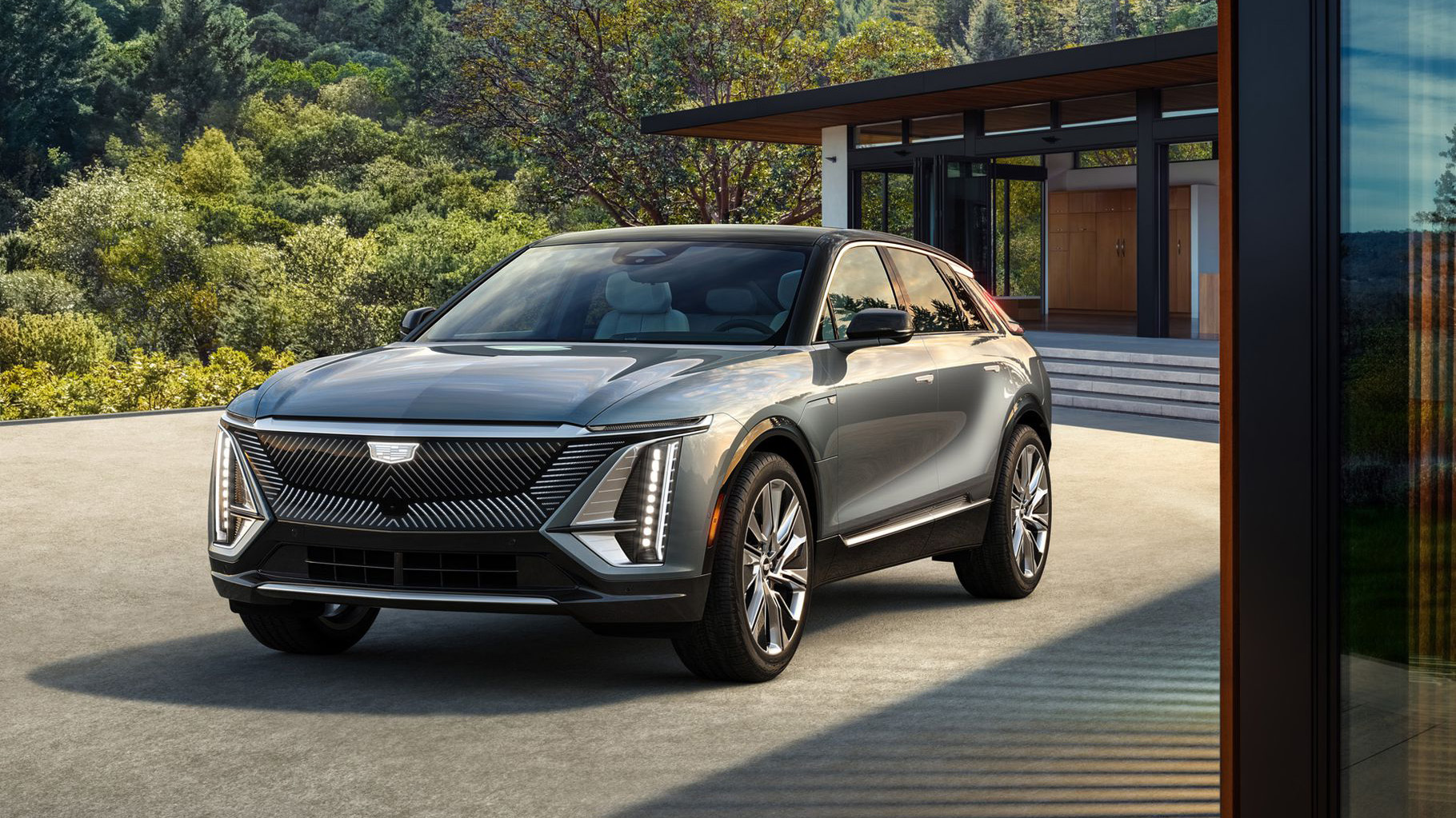
With Cadillac moving towards an all-electric future in the U.S. the Cadillac Lyriq SUV is going to be an important new model. Fitted with a 100kWh battery, the Cadillac could be capable of 300 miles of range, which might tempt buyers away from the Tesla Model X. Crucially, though, prices will be starting at a very competitive $59,990.
Models will come in either a dual motor, all-wheel-drive version or a rear-wheel-only drive edition. Importantly, GM has partnered with EVgo to let Lyriq owners use its national charging network and the Caddy will be able to handle up to 150kw connections. Exterior styling is subtly ostentatious while the interior, as you’d expect from Cadillac, features plenty of comfort and a dominant 33-inch display up front.
Ford F-150 Lightning (Expected: 2022)

Ford’s hugely popular truck now has pricing confirmed and, considering the existing one starts at just over $30,000, making the move from a gas model to the all-electric edition isn’t too much of a jump. The base level cost for a 2022 Ford F-150 Lightning will be around $40,000 (plus the mandatory destination charge), while an XLT edition will be in the region of $55,000.
Premium models, the Lariat and Platinum with their associated trim options have yet to be announced, but could cost as much as $90k. Styling is suitably rugged and boasts many of the same features and functions that have made earlier F-150’s such a huge hit. Meanwhile the interior can be boosted by choosing from one of four trim levels.
However, there’s only one body style with a sizeable four-door SuperCrew Cab and a 5.5-foot bed option to choose from, which should ensure the all-electric EV will hit mass-market appeal head-on.
Genesis Electrified G80 (Expected: 2021)
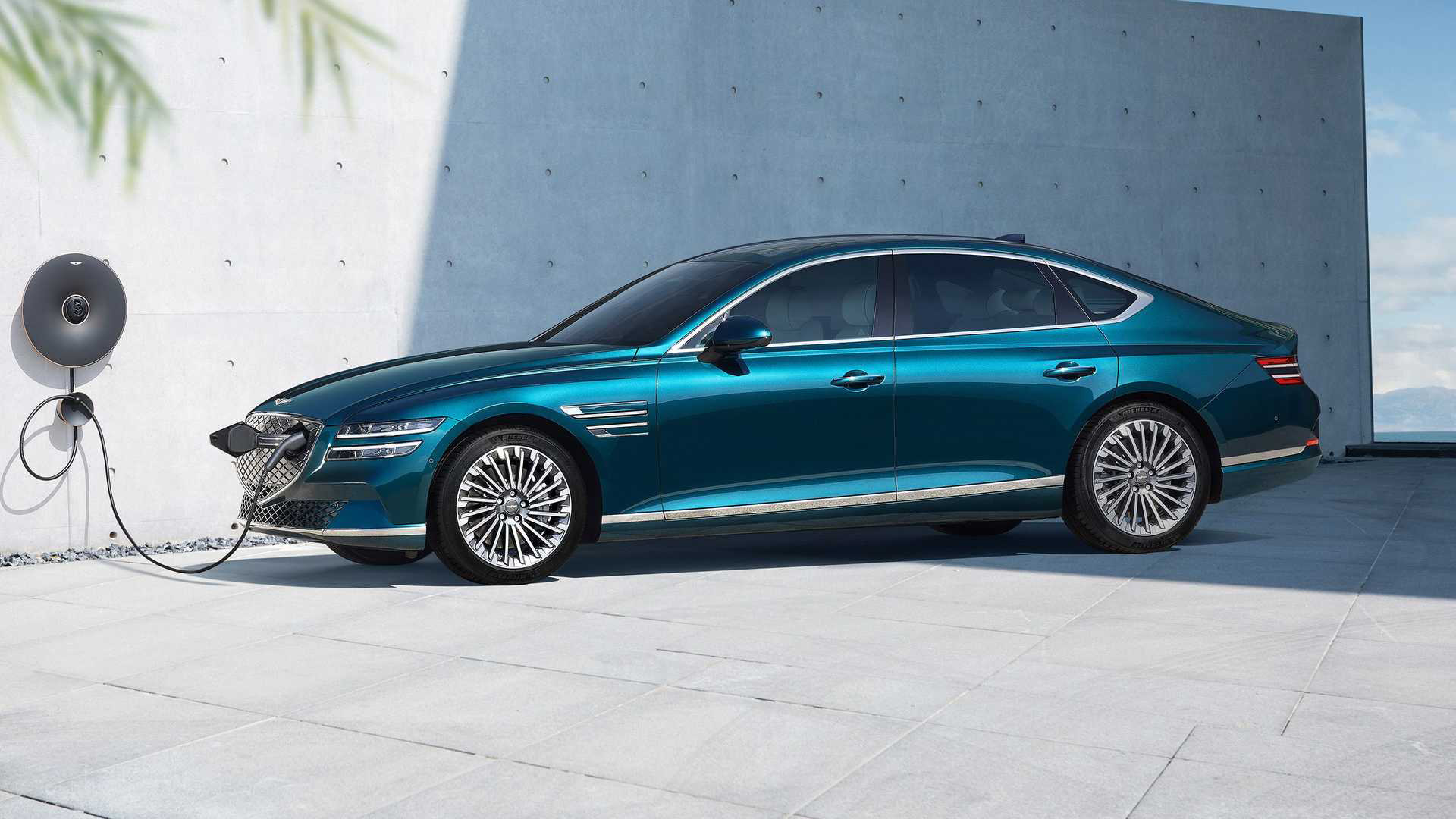
The luxury division of Hyundai means that Genesis has plenty of development muscle behind it, and the first battery-model to appear will be the Electrified G80. Already unveiled at the Shanghai Auto Show in April 2021, performance for the sedan sounds promising, with a 0-60mph time said to be 4.9 seconds, a range of up to 265 miles and fast recharging capability of 10% to 80% in just 22 minutes. There’s also a solar roof too, which is also being seen on Hyundai’s Ioniq 5, though details of just how useful this will be in reality remains to be seen.
GMC Hummer EV Edition 1 (Expected: 2021)

Love it or loathe it, the GMC Hummer is expected to live on with the GMC Hummer EV Edition 1. Set to feature everything you’d expect from the brand, it’ll feature beefy on and off-road capabilities along with Hummer specialities such as underbody armor and, unsurprisingly, a giant battery.
The heavyweight vehicle will need it too, and performance is expected to be as formidable as you’d expect with the three-motor, all-wheel-powertrain expected to propel the EV Edition 1 from zero to 60mph in just 3 seconds. It should come armed with all of the toys you’d anticipate from this $112,595 vehicle, including GM’s Super Cruise semi-autonomous driving mode.
Hyundai Ioniq 5 (Expected: 2021)

This will be the first of Hyundai’s new all-electric sub-brand to use the Ioniq moniker, though certainly not the last, with more offerings on the cards. Designed around the E-GMP platform devised by Hyundai and Kia there are plans afoot for no less than 23 EVs over the course of the next four years or so.
The Hyundai Ioniq 5 is a mid-size crossover SUV that manages to blend bold styling with plenty of space on the inside. The 20-inch wheels, clam-shell hood and imposing front and rear lights make a statement. Meanwhile, the interior packs in some clever tricks, like a sliding center console, twin 12.25-inch screens on the dash along with a head-up display adding tech interest.
You’ll be able to buy the Ioniq 5 in all-wheel-drive or rear-wheel-drive only with two battery sizes for good measure. The dual motor, all-wheel-drive model looks particularly interesting with 302bhp, a 0-62mph time of 5.2 seconds and a top speed of 115mph.
Jeep Wrangler Magneto EV (Expected: 2022)

Jeep’s Wrangler is an instantly recognisable design that’s been around for what seems like forever. But it could soon be revitalised with this Magneto EV concept. On face value you’re getting a Wrangler Rubicon, but underneath that familiar exterior lies an 800-volt system of quad battery packs that work together to produce 285 horsepower.
While it’s still firmly in concept mode, the Magneto is also interesting in that it features a six-speed manual transmission. Quite how things will pan out in terms of a production vehicle remains to be seen, but considering this vehicle is based on a 2020 Jeep Wrangler Rubicon, the rugged off-road design is halfway there already.
If you're after something a little less flashy, the still-unnamed Electric Jeep is set to arrive in 2023.
Kia EV6 (Expected: 2022)

Kia’s EV6, EV6 GT-Line and EV6 GT models will be on sale in Europe before the end of the year, but the arrival and pricing for the U.S. is yet to be confirmed. Interest is likely to be high, not only because of the EV6’s vibrant styling and zesty performance but also because of its neat array of features.
The long-range edition of the EV6 GT features a 77.4kWh battery and a twin motor, all-wheel-drive powertrain that delivers 316 miles of range and 0-62 mph in an impressive 3.5 seconds. Top speed is 160mph. Meanwhile, tech highlights include an AR head-up display plus Level 2 autonomous driving features. The car can even be used to recharge other EVs with its own battery, while charging the EV6 itself from 10% to 80% can be achieved in just 18 minutes.
Lexus EV SUV (Expected: 2022)

Lexus recently confirmed its plans for a full electric model for 2022. The car is likely to be based around the pretty funky LF-Z Electrified concept, which packs in plenty of delicious styling touches with a few that make it unmistakeably Lexus. Touches like the trademark spindle grille.
Lexus has been working with Subaru and parent company Toyota to place the concept on its new bZ architecture. The resulting production car could feature a twin motor, all-wheel-drive powertrain with a 90kWh battery and, potentially, up to 373 miles of range. Alongside the radical styling there could be quirks too, including a solar charging panel and a steer-by-wire system.
Lordstown Endurance (Expected: 2021)

News broke of the Lordstown Endurance on the same day as Tesla took the covers off its Cybertruck. While it’s hardly as radical in design as Elon Musk’s vision this is a pick-up truck that looks like becoming a reality as deposits are already being taken.
With its all-electric, four-wheel-drive hub motor setup the Ohio-built truck comes with a range said to be around 250 miles and a claimed 600 horsepower. Prices start at $52,500, which given the specification sounds like a pretty good deal. Especially considering the chunky styling that looks rather classy if the manufacturer’s pre-production images are anything to go by.
Lotus Evija (Expected: 2021)

Hypercars don't come much more hyper, or limited, than the Lotus Evija. The iconic British manufacturer is only producing 130, with a price tag of over $2.3 million apiece, plus the option for lots of custom options for owners too.
While the looks are radical it's the performance that’ll make the Evija even more of a head turner, with an electric motor at each wheel plus a 70kWh battery and power management system produced by Formula 1 specialists Williams Advanced Engineering.
Lotus predicts 2,000hp will be available when the finished car arrives, with 1254lb-ft of torque and a 0-62mph time of under three seconds. The car will reach 186mph in less than 9 seconds while the top speed is expected to be around 200mph. Charging the car could be just as rapid, with Lotus planning to make the car capable of fast charging from a 350kW outlet, if you can find one.
Lucid Air (Expected: 2021)

Featuring a strong whiff of West Coast inspiration, the Californian start-up behind this car has produced a great looking machine, which looks set to have plenty going for it. Prices for the Lucid Air start at $69,900 while the specs appear similarly impressive. There’s a reported 500-plus mile range, a 0 to 60mph time of just 2.5 seconds and the ability to cover a quarter mile in just 9.9 seconds.
All that comes from an apparently miniaturized EV powertrain that still delivers over 1,000 horsepower. Keeping things as green as possible, the Lucid Air will feature a range of sustainable materials and finishes throughout. The design also purports to feature the largest frunk of any electric car, gained obviously by the fact that there’s no conventional engine to get in the way.
Mazda MX-30 (Expected: 2022)

Already available in Europe, the Mazda MX-30 is the Japanese automaker’s fully-electric crossover that has a whiff of its CX-30 model, but adds in lots of quirky touches. Highlights include the smooth lines of the body, forward opening rear doors and an interior that comes with cork flourishes.
While the MX-30 is fairly conservative on the performance side of things, with a small 35.5kWh battery that delivers a range of 124 miles, it’s perfectly well suited to commuting and for shopping trips. Mazda still hasn’t confirmed pricing for the U.S. edition, but it’s rumoured to be in the $35,000 ballpark.
Mercedes-Benz EQA (Expected: 2022)
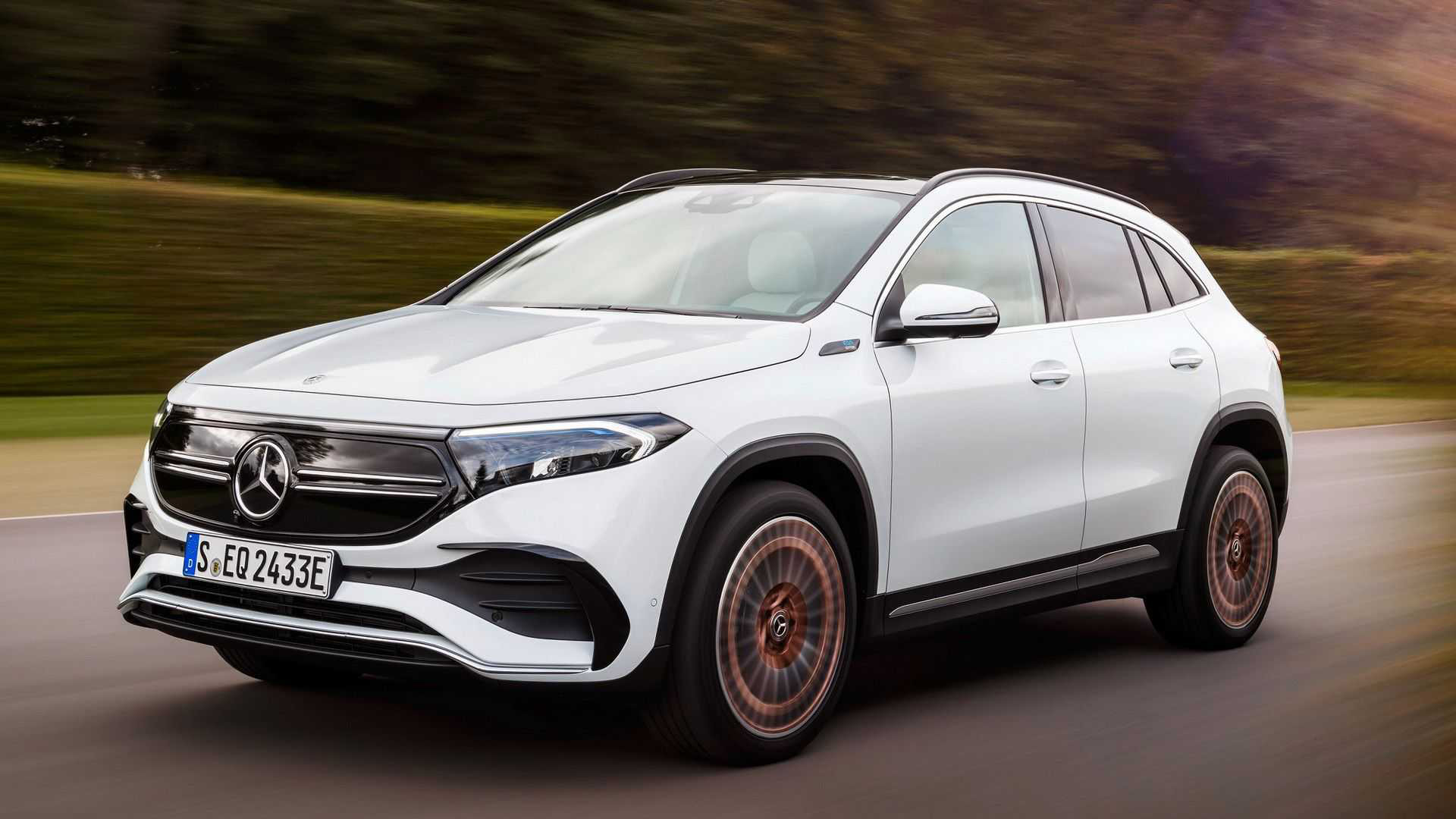
Just part of a growing family of EQ vehicles, the Mercedes-Benz EQA sits at the smaller end of the model spectrum. This compact SUV has a European edition, which features 187 horsepower and 277lb-ft of torque, with a price tag around the $57,000 mark.
However, the model aimed at the U.S. market could be a little more substantial, with all-wheel-drive, 280 horses and a range in the region of 250 miles. In terms of styling the looks are reminiscent of entry-level SUV, the GLA, but with some neat flourishes that highlight its all-electric credentials, especially the grille.
Mercedes-Benz EQB (Expected: 2022)
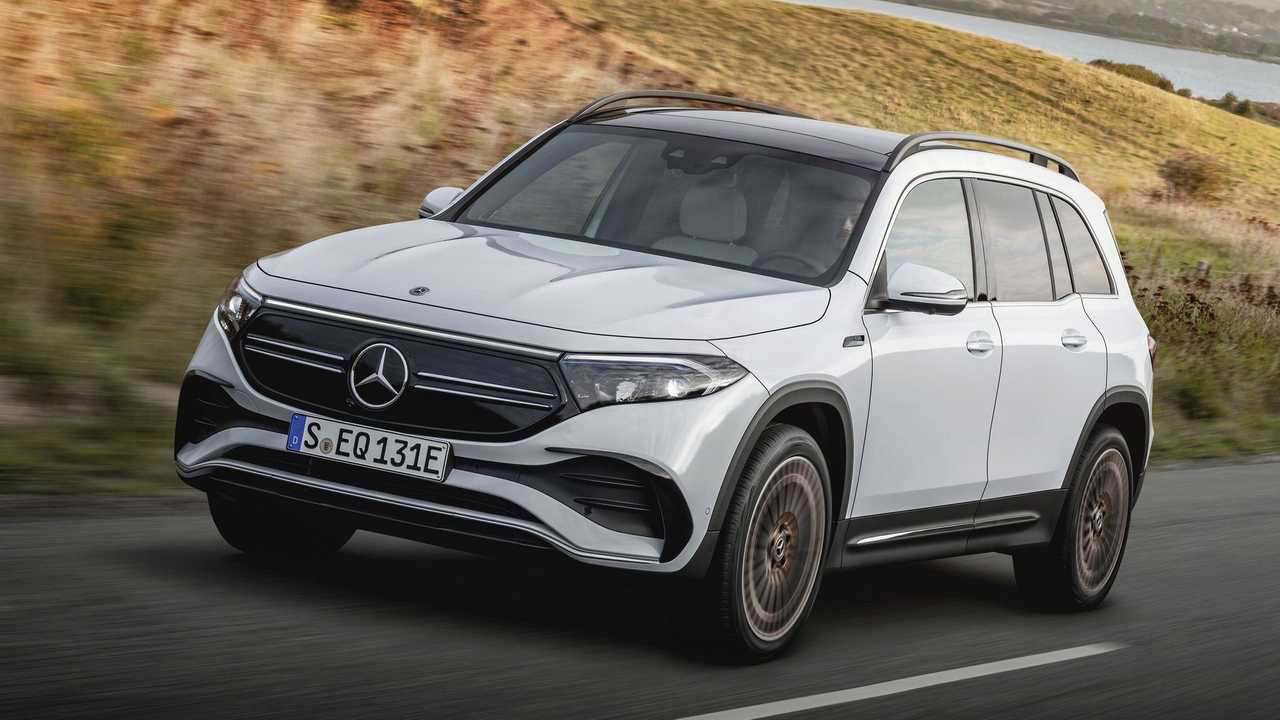
The big, burly Mercedes EQB will first appear in China with a U.S. edition rumoured to arrive sometime next year. And, if you’re looking for space to seat every member of your extended family then this could be the vehicle for you. The EQB will feature a seating layout that lets you get no less then seven people inside thanks to three rows of seats.
Currently there’s the EQB 250 and EQB 350 scheduled, with the former offering 187bhp from a 66kWh battery and a range of around 260 miles. The larger EQB 350 model should deliver around 240bhp, with other models hinted at including a long-range edition. There’s plenty of style on offer externally, while the interior tech includes the Mercedes-Benz MBUS infotainment system.
Mercedes-Benz EQC (Expected: 2021)

Already on sale in the U.K., Mercedes-Benz looks like bringing this all-electric SUV Stateside later this year, with prices expected to start at just under the $70,000 mark. Taking a nod from the GLC, the car features an 80kWh battery pack mated to asynchronous electric motors mounted to each axle.
The Mercedes EQC produces 408hp, which should result in decent performance, with a 0-62mph time of just 5.1 seconds and a top speed of 112mph. The look is less inspiring however, with nothing particularly new to report other than smoother lines that make it a little more aerodynamic. Mercedes-Benz has used its imagination a little more on the inside, with the ambient lighting and an imposing twin widescreen infotainment system being the most striking elements.
Mercedes-Benz EQE (Expected: 2022)

This could end up being a dinkier take on the Mercedes-Benz EQS, and rather like an EV edition of the E-Class. Details on the car are currently pretty sparse, although details rumoured so far put the SUV as potentially having 430 miles of range, dependent on the version. The design should also be able to accommodate a 100kWh battery pack.
In fact, it seems likely that the EQE badge will be used on two different models, including a large saloon that'll be available alongside the SUV edition. The design will make use of the same platform as the one being incorporated into the EQS, and the flexibility of this new architecture means that several different models and specifications could be possible. Watch this space.
Mercedes-Benz EQS (Expected: 2021)
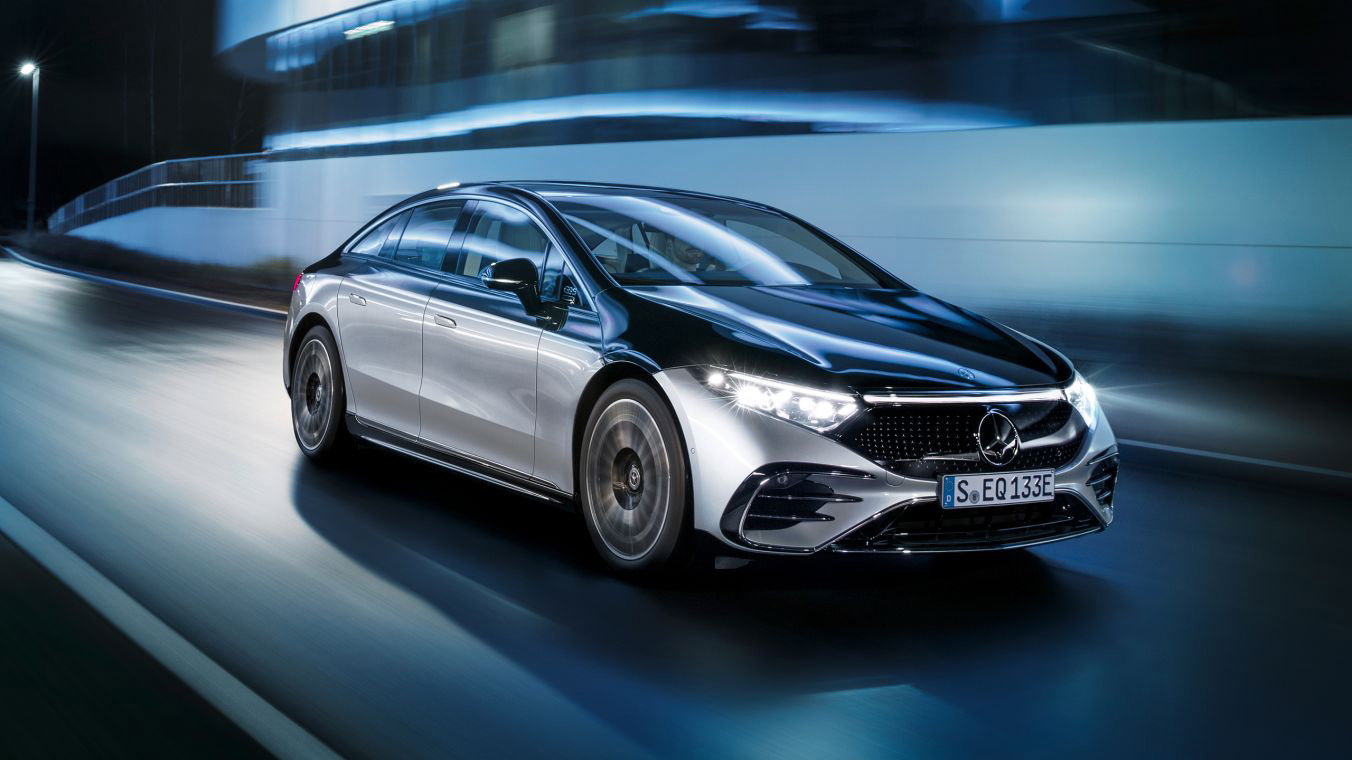
Expect luxury all the way with the arrival of the Mercedes EQS, with two model variants planned for the U.S. market: the EQS 450+ and the livelier EQS 580 4MATIC. No pricing has been confirmed, but your dollars will get you lots of sleek and sophisticated lines looking from the outside, and high-levels of sophistication on the inside.
Dominated by the MBUX (Mercedes-Benz User Experience) Hyperscreen the car will also come fully-loaded with the latest series of driver aids and safety features. Power comes via a 107kWh battery pack with the EQS 450+ producing 329 horsepower through an electric powertrain (eATS) attached to its rear axle.
Meanwhile, the EQS 580 4MATIC is more powerful with an all-wheel-drive arrangement using an eATS connected to both axles that provides 516 horsepower and a sizeable 611lb-ft of torque.
Mercedes-Benz G-Class Electric (Expected: 2022)

There’s no mistaking the classic lines of the G-Class and, it seems, Mercedes-Benz does have plans in place for making an all-electric variant in the not-too-distant future. Although many thought the rise of EVs could mark the end of vehicles like the G-Class, it could actually mean they live on - although a plug-in hybrid edition of the existing model looks more likely in the short-term.
Nevertheless, Daimler CEO Ola Källenius has hinted at an all-electric incarnation of the G-Class, which may, or may not re-emerge as the EQC, which would bring it in line with the naming convention of other EVs in the Mercedes-Benz range.
Nissan Ariya (Expected: 2021)

Pinned as direct competition to the Tesla Model Y, the Nissan Ariya is expected to be available in five different models. The entry-level, two-wheel-drive model will sport a 63kWh motor, delivering 215bhp and push the car from zero to 62mph in 7.5 seconds. The all-wheel-drive, 87kWh model boasts 239bhp and will get from 0-60mph in 7.6 seconds using Nissan’s new e-4orce system.
This looks to be used to best effect in the high-end Ariya e-4orce 87kWh Performance though, with its 389bhp getting the car from zero to 60mph in just 5.1 seconds. Alongside the impressive looks will be lots of tech including, on the inside, a 12-inch infotainment screen, Nissan’s ProPilot driver assistance, voice commands and its e-pedal, which already works to such great effect in the Nissan LEAF. Prices are set to start around the $40,000 mark.
Pininfarina Battista (Expected: 2021)

Underlining the fact that EV’s aren't just about being greener and conservative as a result, the Pininfarina Battista is another in the growing range of performance electric hypercars. Anyone suitably well-heeled enough to afford the Battista will be able to enjoy scintillating performance from a 120kWh battery pack, plus power delivered to all four wheels from a quartet of motors producing a combined out of 1,400kW and 2,300Nm of torque.
Largely carbon-fibre, the car is light, very aerodynamic and can accelerate from 0-60 in under two seconds. Top speed is estimated to be around 217mph. Interiors can be finished as you desire, and because every car is hand-built, deliveries should slowly begin later this year.
Porsche Macan EV (Expected: 2023)

There’s a Porsche Macan EV on the horizon, but currently it’s so far off in the distance that we won’t actually see it until 2023. Which is why our image is of an existing model. Porsche hinted at the idea a couple of years ago and, with the Macan having been a big seller in the U.S., it makes sense for the German automaker to develop an EV edition.
Details are on the skimpy side though, but it’s thought that the Porsche Macan EV will be based around the 800-volt charging architecture that’s been used for the Porsche Taycan EV. If that’s the case then, as you’d expect from Porsche, things should be premium quality and performance focused. As an example, the Taycan features 79.2kWh or 93.4kWh battery options, while range is expected to be slightly better at around 227 miles.
Rivian R1T (Expected: 2021)
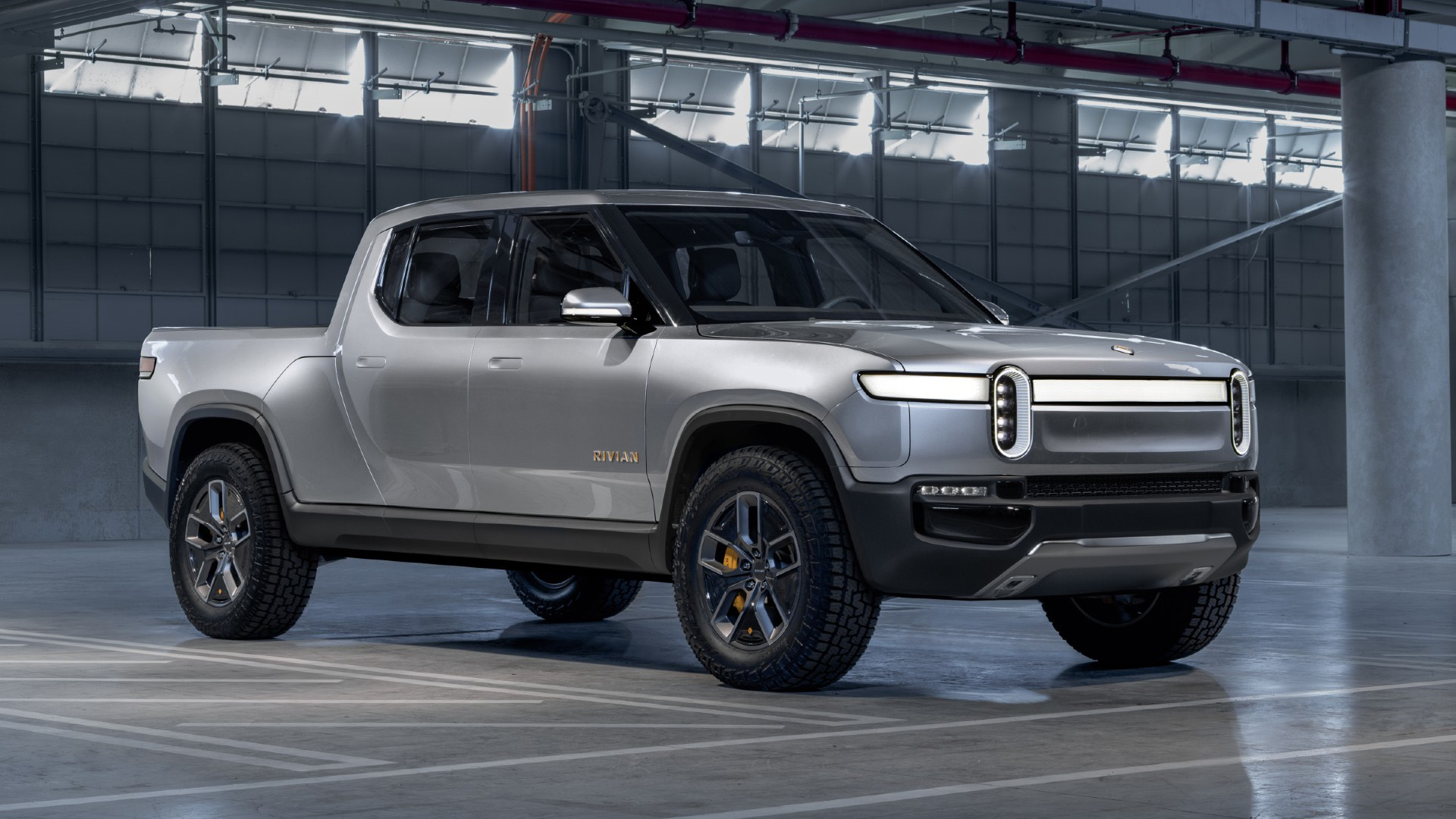
Rugged looks backed up by an equally craggy specification makes the Rivian R1T a tantalizing proposition and, it seems, trucks should be ready to go before the end of the year. The start-up company has already developed this fully electric pickup, available in three different battery pack options including 105, 135 and 180kWh variants.
The one to go for if you’re looking for performance is obviously the beefier edition, with a zero to 60mph time said to be circa 3 seconds. While the three models can offer a range of 230, 300 and 400 miles respectively it’s the appeal of the trucks’ capacity to pull up to 11,000 pounds that is likely to endear it to many. Added to that, the exterior styling is crisp and clean too. It starts at $67,500.
Rivian R1S (Expected: 2021)

If you’re in the market for a Rivian and want a pure SUV then you’re in luck as the R1S is just that. Based on the same architecture used for the R1T, this is perfect for carrying people rather than cargo. Indeed, the beefy SUV might have less towing capacity, at just 7716 pounds, but it more than makes up for that with plenty of space inside.
In fact, the Rivian R1S has the capacity to seat up to seven people. Meanwhile, the exterior packs in the same distinctive styling as seen on the pick-up truck and with a price tag of $70,000 looks like it could do well, especially given its 300-plus miles of range.
Tesla Cybertruck (Expected: 2022)

Rather more angular than other Tesla creations to date, the much-hyped Cybertruck is on the horizon although growing demand for other models across the range could see the 2022 launch date slide. It looks like being worth waiting for though, with prices starting at just $39,900 for a single motor, rear-wheel-drive edition.
The all-wheel-drive model looks set to cost $49,900, while a three motor, all-wheel-drive Tesla Cybertruck will cost $69,900 according to figures from Tesla. The truck is designed to be tough, being built from ultra-hard 30x cold-rolled stainless steel, but also quite accommodating with seating for up to six people plus a flatbed out back. Range estimates so far are 250 miles, 300 miles and 500 miles for the three respective models.
Tesla Roadster (Expected: 2022)

The Tesla Roadster 2022 is eagerly anticipated and for good reason. Set to feature the company’s Plaid triple motor powertrain design, the performance looks set to be blinding. As has already been seen with Tesla’s Model S and X Plaid cars, the extra power available from this powertrain setup delivers dazzling performance.
The Roadster should get that and, thanks to its hugely aerodynamic design and lightweight build will, quite possibly, deliver a 0-60mph time of 1.9 seconds, a 0-100mph time of 4.2 seconds along with a top speed thought to be over 250mph. Its 200kWh battery pack should also be good for around 620 miles of range, although the performance comes at a price, with base level models starting in the region of $200,000.
Toyota bZ4X Concept (Expected: 2022)

Although it’s so far only been seen in purely demonstration form, most recently at the Shanghai Auto Show, the Toyota bZ4X Concept is an all-electric creation that is based on the e-TNGA architecture.
Developed in a collaboration with Subaru this will allow the electric SUV to feature all-wheel-drive while also delivering a roomy, high-up driving experience that’s not a million miles away from the current Toyota RAV4. While more details on the actual specification are thin on the ground at the moment, the Japanese automaker has plenty of images, which show the car to be cool on the outside and nicely appointed on the inside.
Volkswagen I.D. Space Vizzion (Expected: 2022)

While wagons are something of a hard sell to the U.S. car-buying public, the Volkswagen I.D. Space Vizzion might stir up some interest. It’s another concept and currently one of seven EVs from the German automaker that utilise its MEB electric vehicle platform.
But even if wagons don't float your boat this one might change all that, as it’s definitely a looker. Performance-wise it’s expected to deliver 300 miles of range from the 82kWh battery, and features lively acceleration that could see it achieve zero to 60mph in around 5 seconds. VW also plans for the I.D. Space Vizzion to have 150kW DC fast-charging too, along with offering a 275 horsepower, rear-wheel-drive model or a zestier 335 horsepower edition.
Volvo C40 Recharge (Expected: 2022)

Already a common sight in its XC40 guise, the Volvo C40 Recharge is the perfect blend of Scandinavian style and all-electric efficiency. However, the C40 Recharge is a little bit different in that it’s a sportback edition of the design, and purely EV, so no other versions are available.
That’s a good thing, although the powertrain is the same as that found in the XC40. So expect a 75kWh battery pack, around 402 horsepower from two electric motors and an anticipated range of about 210 miles. Zero to 60mph is expected to be in the region of 4.7 seconds and, this being a Volvo, you’ll doubtless get there in refined comfort too. Prices should start at around $55,000.
- More: The best thing about driving an electric car — but it isn't what you think

Rob is a London-based freelance tech journalist covering EVs and car tech for Tom's Guide. He has worked at Microsoft and written for numerous tech sites including TechRadar, Gizmodo, ShortList and Fit&Well. When he's not working, he can usually be found out and about on one of his numerous ebikes.
